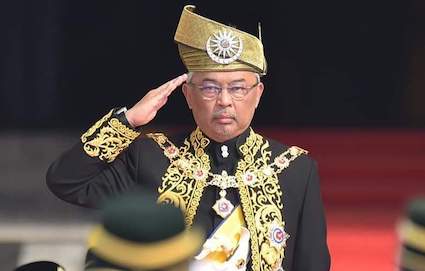Can the Agong sack the Prime Minister?

Malaysia has FOUR branches of government: the Executive (PM), the Monarchy (the Agong and the Conference of Rulers), the Legislature (Parliament) and the Judiciary (Courts and Judges). And the reason the British did this was so that there would be checks-and-balances and separation of powers. So please understand how Malaysia’s system works before shooting your mouth off.
NO HOLDS BARRED
Raja Petra Kamarudin
There you go. The “Kerajaan Pintu Belakang” campaign has failed. Then the “Kerajaan Gagal” campaign failed as well. And now the campaign has shifted to “who calls the shots, the Prime Minister or Seri Paduka Baginda Yang di-Pertuan Agong”?
This new campaign is meant to create the perception that the Agong and not the Prime Minister decides on the Emergency (whether to have one and when it should end) and that the Agong has the power to sack the Prime Minister and replace him with someone else.
The first Prime Minister, Tunku Abdul Rahman, wrote about this matter many years ago. The Tunku wrote that a British cabinet minister tried to barge his way into the PM’s office without an appointment and was refused entry.
This British cabinet minister then had an audience with Seri Paduka Baginda Yang di-Pertuan Agong (Tuanku Abdul Rahman of Negeri Sembilan) and complained about this incident. He also suggested that the Agong sack the PM, to which the Agong replied that according to Malaysia’s Constitution, the PM can sack the Agong, but the Agong cannot sack the PM.
In fact, this was what Tun Dr Mahathir Mohamad kept telling Malaysians during the Constitutional Crisis of the 1980s (that the Agong cannot sack the PM). Umno even joked that, in Malaysia, the Agong rules for only five years while the PM rules for life whereas, in the UK, the King/Queen rules for life and the PM rules for only five years.
In no uncertain terms, the Tunku and Mahathir both stated that under Malaysia’s constitutional monarchy system, the PM has certain powers and the Agong has certain powers. That is called power-sharing and checks-and-balances, something Mahathir resented in the 1980s and tried to change so that he had absolute power and could override the Agong.
In short, neither the PM nor the Agong has 100% say. What they can and cannot do is stated in the Federal Constitution of Malaysia. Hence all those comments from politicians about the Emergency (Darurat) and Majlis Gerakan Negara (Mageran) or National Operations Council (NOC) is an exercise in mental masturbation or “Shiok Sendiri”.
Let us be very clear about what the law and Constitution say about the matter. And to make it simple for simple-minded people to understand, let me summarise it in the most concise and precise manner:
1. The Agong is not empowered to proclaim an emergency for the Federation of Malaysia unless it is on the advice of the Prime Minister.
2. By Article 40(1) and (1A) of the Federal Constitution, the Agong is required to and must act on the advice of the Prime Minister. To act against the advice of the Prime Minister is a violation of the Federal Constitution and the rule of law.
3. The Agong’s power to exercise his personal discretion is limited to specific provisions of the Federal Constitution. The instances where the Agong has the power to exercise his personal discretion under the Federal Constitution are clearly identifiable with the use of a specific type of constitutional language.
4. There is nothing in Article 150 of the Federal Constitution which indicates, in any way, that the Agong has the personal discretion to proclaim an emergency.
5. The Agong is a constitutional monarch. The Agong ‘reigns but does not rule’. In so doing, the Agong provides a check and balance to the Executive and Parliament. This check-and-balance is a residual power. It does not allow the Agong to violate the separation of powers provided for in the Constitution.
Okay, do I still need to make that clearer or is it clear enough? Malaysia has FOUR branches of government: the Executive (PM), the Monarchy (the Agong and the Conference of Rulers), the Legislature (Parliament) and the Judiciary (Courts and Judges). And the reason the British did this was so that there would be checks-and-balances and separation of powers. So please understand how Malaysia’s system works before shooting your mouth off.

